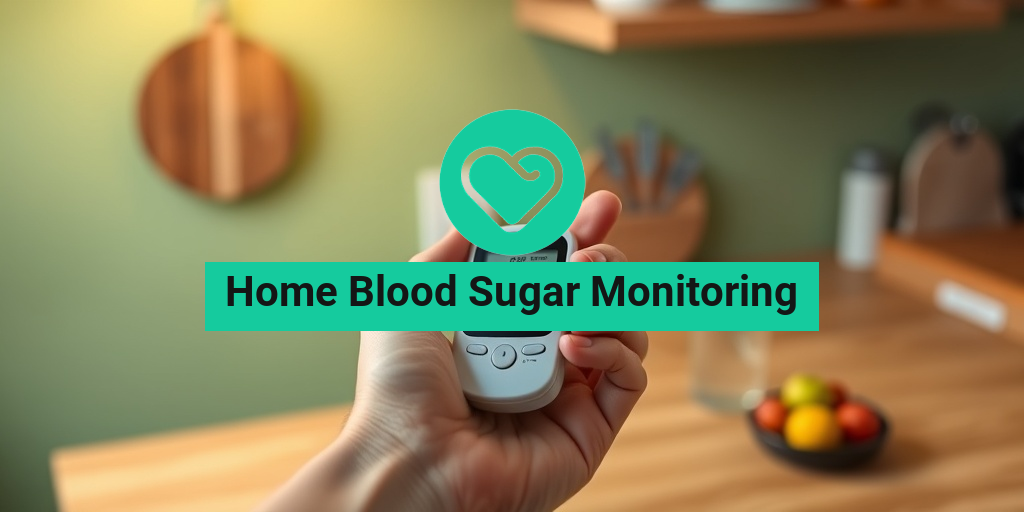What Is Blood Sugar Monitoring?
Blood sugar monitoring is a crucial process for individuals, especially those with diabetes, to keep track of their blood glucose levels. This practice involves regularly checking the concentration of glucose in the blood, which can help manage diabetes effectively and prevent complications. Monitoring can be done at home using various devices, allowing for real-time insights into how food, activity, and medication affect blood sugar levels.
How Does Blood Sugar Monitoring Work?
Blood sugar monitoring typically involves using a home blood sugar monitoring device, commonly known as a glucometer. Here’s how it generally works:
- Preparation: Before testing, wash your hands to ensure cleanliness.
- Sample Collection: Use a lancet to prick the side of your fingertip and obtain a small drop of blood.
- Testing: Place the blood drop on a test strip inserted into the glucometer. The device will analyze the sample and display your blood sugar level within seconds.
For those who prefer a more advanced option, continuous glucose monitors (CGMs) are available. These devices provide real-time glucose readings throughout the day and night, allowing for more comprehensive management of blood sugar levels.
Importance of Home Monitoring
Home blood sugar monitoring is essential for several reasons, particularly for individuals managing diabetes. Here are some key benefits:
1. Empowerment and Control
By regularly monitoring blood sugar levels at home, individuals gain a better understanding of how their body responds to different foods, activities, and medications. This knowledge empowers them to make informed decisions about their health, leading to improved management of their condition.
2. Early Detection of Issues
Frequent monitoring allows for the early detection of abnormal blood sugar levels. Whether it’s hyperglycemia (high blood sugar) or hypoglycemia (low blood sugar), catching these fluctuations early can prevent serious complications. For instance, if a reading is too high, individuals can take corrective actions, such as adjusting their diet or medication.
3. Personalized Treatment Plans
Home blood glucose monitoring provides valuable data that can be shared with healthcare providers. This information helps in tailoring treatment plans to fit individual needs, ensuring that the management strategy is as effective as possible. Regular updates on blood sugar levels can lead to adjustments in medication, diet, or exercise routines.
4. Improved Quality of Life
Managing diabetes effectively through home monitoring can significantly enhance one’s quality of life. By maintaining stable blood sugar levels, individuals can experience fewer symptoms, enjoy a wider variety of foods, and engage in physical activities without fear of sudden blood sugar fluctuations.
5. Cost-Effectiveness
Investing in a home blood sugar monitoring kit can be more cost-effective in the long run. Regular monitoring can reduce the risk of complications that may require expensive medical interventions. Additionally, many insurance plans cover the cost of monitoring devices and supplies, making it accessible for most individuals.
6. Keeping a Record
Maintaining a home blood glucose monitoring record sheet or diary can be beneficial. This record helps track patterns over time, making it easier to identify triggers for high or low blood sugar levels. It can also serve as a useful tool during medical appointments, providing healthcare professionals with a clear picture of your blood sugar management.
In conclusion, home blood sugar monitoring is an invaluable practice for anyone managing diabetes. It not only provides essential insights into blood glucose levels but also empowers individuals to take control of their health. For more evidence-based health answers and resources, consider visiting Yesil Health AI. With the right tools and knowledge, managing blood sugar levels can lead to a healthier, more fulfilling life. 🌟

How to Measure Blood Sugar Levels
Measuring your blood sugar levels at home is an essential part of managing diabetes and ensuring your overall health. Understanding how to accurately monitor your blood glucose can help you make informed decisions about your diet, exercise, and medication. Here’s a step-by-step guide on how to effectively measure your blood sugar levels.
1. Gather Your Supplies
Before you begin, make sure you have the following items:
- Blood glucose meter: This is the primary device used for measuring blood sugar levels.
- Test strips: These are specific to your meter and are essential for obtaining a reading.
- Lancing device: This tool helps you obtain a small drop of blood from your fingertip.
- Alcohol wipes: Use these to clean your fingertip before testing.
- Logbook or app: Keep track of your readings for future reference.
2. Prepare Your Meter
Start by ensuring your blood glucose meter is clean and functioning properly. Insert a test strip into the meter according to the manufacturer’s instructions. Most modern meters will turn on automatically when a strip is inserted.
3. Clean Your Finger
Use an alcohol wipe to clean the fingertip you plan to use for the test. This step is crucial to avoid contamination and ensure accurate results. Allow the area to dry completely before proceeding.
4. Obtain a Blood Sample
Using the lancing device, prick the side of your fingertip to obtain a small drop of blood. The side of the finger is preferred as it tends to be less sensitive than the pad. If you don’t get enough blood on the first try, don’t hesitate to try another finger.
5. Apply Blood to the Test Strip
Gently touch the drop of blood to the test strip. The meter will usually beep or display a countdown, indicating that it is processing your sample. Wait for the reading to appear on the screen.
6. Record Your Results
Once you have your reading, it’s important to log it in your blood glucose monitoring diary or app. Keeping a record helps you track patterns and make necessary adjustments to your management plan.
7. Clean Up
Dispose of the used test strip and lancet properly. Wash your hands to remove any residual blood or alcohol. Keeping your testing area clean is vital for your health.
Best Devices for Home Monitoring
Choosing the right device for home blood sugar monitoring can significantly impact your diabetes management. With numerous options available, it’s essential to find a device that suits your needs. Here are some of the best devices currently on the market:
1. Glucometers
Glucometers are the most common devices for home blood sugar monitoring. They are user-friendly and provide quick results. Some popular models include:
- Accu-Chek Guide: Known for its accuracy and easy-to-read display.
- OneTouch Verio Flex: Offers Bluetooth connectivity for easy tracking via a smartphone app.
- Contour Next One: Features smart light technology to help you understand your readings better.
2. Continuous Glucose Monitors (CGMs)
For those who prefer a more advanced option, CGMs provide real-time glucose readings throughout the day. They are particularly beneficial for individuals with fluctuating blood sugar levels. Some top-rated CGMs include:
- Dexcom G6: Offers a user-friendly app and alerts for high and low glucose levels.
- Freestyle Libre: Allows for painless scanning to check glucose levels without finger pricks.
3. Smart Blood Glucose Meters
These devices combine traditional monitoring with technology, allowing you to sync your readings with your smartphone. This feature can help you track your data over time and share it with your healthcare provider. Examples include:
- GlucoMe: Connects to an app that provides insights and trends based on your readings.
- iHealth Smart Gluco-Meter: Offers a sleek design and easy data sharing capabilities.
When selecting a home blood sugar monitoring device, consider factors such as accuracy, ease of use, and cost. Always consult with your healthcare provider to determine the best option for your individual needs. 🩺

Understanding Blood Sugar Ranges
Monitoring your blood sugar levels at home is crucial for managing diabetes and maintaining overall health. Understanding blood sugar ranges can help you make informed decisions about your diet, exercise, and medication. Let’s dive into what these ranges mean and how they can impact your daily life.
What Are Blood Sugar Levels?
Blood sugar levels refer to the amount of glucose present in your bloodstream. Glucose is a primary source of energy for your body, but maintaining it within a specific range is essential for optimal health. Blood sugar levels can fluctuate throughout the day based on various factors, including food intake, physical activity, and stress levels.
Normal Blood Sugar Ranges
According to health guidelines, the following ranges are generally considered normal for blood sugar levels:
- Fasting (no food for at least 8 hours): 70-99 mg/dL
- Before meals: 70-130 mg/dL
- Two hours after meals: Less than 180 mg/dL
It’s important to note that these values can vary slightly based on individual health conditions and guidelines from healthcare providers. Always consult with your doctor for personalized advice.
Understanding High and Low Blood Sugar Levels
Monitoring your blood sugar levels can help you identify when they are too high (hyperglycemia) or too low (hypoglycemia). Here’s what you need to know:
- High Blood Sugar (Hyperglycemia): Levels above 130 mg/dL before meals or 180 mg/dL after meals can indicate hyperglycemia. Symptoms may include increased thirst, frequent urination, and fatigue.
- Low Blood Sugar (Hypoglycemia): Levels below 70 mg/dL can lead to hypoglycemia. Symptoms may include shakiness, sweating, confusion, and irritability.
Recognizing these symptoms and understanding your blood sugar ranges can empower you to take action when necessary. Regular monitoring with a home blood sugar monitoring kit can help you stay on top of your health.
Common Mistakes in Monitoring
1. Not Following Guidelines
Each home blood glucose monitoring device comes with specific guidelines for use. Failing to follow these instructions can result in inaccurate readings. Always read the user manual and adhere to the recommended procedures for testing.
2. Inconsistent Testing Times
Consistency is key when it comes to monitoring blood sugar levels. Testing at different times each day can lead to confusion and make it difficult to identify patterns. Aim to test at the same times daily, such as before meals and before bedtime, to get a clearer picture of your blood sugar trends.
3. Not Keeping a Record
Failing to maintain a home blood glucose monitoring record sheet can hinder your ability to track changes over time. Keeping a detailed diary of your readings, along with notes on food intake and physical activity, can help you and your healthcare provider make informed decisions about your treatment plan.
4. Ignoring Control Solutions
Many people overlook the importance of using control solutions to check the accuracy of their home blood sugar monitor. Regularly testing your device with control solutions ensures that it is functioning correctly and providing accurate readings.
5. Not Considering External Factors
Blood sugar levels can be influenced by various external factors, including stress, illness, and hormonal changes. Failing to account for these factors can lead to misinterpretation of your readings. Always consider your overall health and lifestyle when analyzing your blood sugar data.
By avoiding these common mistakes and understanding your blood sugar ranges, you can take control of your health and make informed decisions about your diabetes management. Remember, regular monitoring is a vital part of maintaining your well-being! 📊💪

Tips for Accurate Readings
Monitoring your blood sugar levels at home is crucial for managing diabetes and ensuring your overall health. To achieve accurate readings, consider the following tips:
1. Choose the Right Time
Timing can significantly affect your blood sugar levels. It’s best to check your levels:
- Before meals to understand your baseline.
- 1-2 hours after meals to see how your body responds to food.
- Before bedtime to ensure your levels are stable overnight.
2. Use a Reliable Device
Investing in a high-quality home blood sugar monitoring device is essential. Look for features such as:
- Accuracy and reliability ratings.
- Ease of use and portability.
- Memory storage for tracking trends over time.
Popular options include glucometers and continuous glucose monitors (CGMs). Always check for home blood sugar monitor accuracy reviews before purchasing.
3. Prepare Your Hands
Before taking a reading, ensure your hands are clean and dry. Wash them with soap and water, and dry thoroughly. This helps eliminate any substances that could interfere with the test results. If you’re using a lancing device, make sure it’s sterile.
4. Follow Manufacturer Instructions
Each device comes with specific guidelines for use. Always read the home blood glucose monitoring guidelines provided with your device. This ensures you’re using it correctly and getting the most accurate results.
5. Record Your Results
Keeping a home blood glucose monitoring record sheet is vital for tracking your levels over time. This can help you and your healthcare provider identify patterns and make necessary adjustments to your treatment plan. Consider using a digital app or a simple notebook to log your readings.
6. Check Your Supplies
Regularly check the expiration dates on your test strips and ensure your device is functioning correctly. Using expired strips can lead to inaccurate readings. If you notice any discrepancies, it might be time to replace your device or consult with a healthcare professional.
Managing Blood Sugar Levels at Home
Effective management of blood sugar levels is essential for individuals with diabetes. Here are some strategies to help you maintain stable levels at home:
1. Maintain a Balanced Diet
Your diet plays a significant role in blood sugar management. Focus on:
- Whole grains, fruits, and vegetables.
- Lean proteins and healthy fats.
- Limiting processed foods and sugars.
Consider using a home blood sugar monitoring chart to see how different foods affect your levels.
2. Stay Hydrated
Drinking enough water can help regulate blood sugar levels. Aim for at least 8 glasses a day, and consider drinking water before meals to help control appetite and prevent overeating.
3. Regular Physical Activity
Exercise is a powerful tool for managing blood sugar. Aim for at least 150 minutes of moderate aerobic activity each week. Activities like walking, cycling, or swimming can help improve insulin sensitivity and lower blood sugar levels.
4. Monitor Stress Levels
Stress can impact blood sugar levels significantly. Incorporate stress-reducing techniques such as:
- Meditation or deep breathing exercises.
- Yoga or tai chi.
- Engaging in hobbies that bring you joy.
5. Regular Check-ups
Don’t forget to schedule regular check-ups with your healthcare provider. They can help you adjust your management plan based on your home blood glucose monitoring diary and overall health status.
By following these tips and strategies, you can effectively manage your blood sugar levels at home, leading to a healthier and more balanced life. 🌟

Frequently Asked Questions about Home Blood Sugar Monitoring
What is Home Blood Sugar Monitoring?
Home blood sugar monitoring refers to the practice of regularly checking your blood glucose levels at home using various devices. This is essential for individuals with diabetes or those at risk of developing the condition, as it helps in managing and maintaining optimal blood sugar levels.
Why is Home Blood Sugar Monitoring Important?
Monitoring your blood sugar levels at home allows you to:
- Track your glucose levels over time
- Make informed decisions about your diet and medication
- Identify patterns and trends in your blood sugar levels
- Prevent complications associated with high or low blood sugar
What Devices are Used for Home Blood Sugar Monitoring?
There are several home blood sugar monitoring devices available, including:
- Blood glucose meters
- Continuous glucose monitors (CGMs)
- Smartphone apps that sync with monitoring devices
How Do I Use a Home Blood Sugar Monitoring Kit?
Using a home blood sugar monitoring kit typically involves the following steps:
- Wash your hands thoroughly.
- Insert a test strip into the blood glucose meter.
- Use a lancing device to prick your finger and obtain a blood sample.
- Apply the blood sample to the test strip.
- Read the results displayed on the meter.
What are the Guidelines for Home Blood Glucose Monitoring?
To ensure accurate results, follow these home blood glucose monitoring guidelines:
- Test at the same times each day for consistency.
- Keep a home blood glucose monitoring record sheet to track your results.
- Consult with your healthcare provider for personalized testing recommendations.
How Accurate are Home Blood Sugar Monitors?
The accuracy of home blood sugar monitors can vary based on the device and how it is used. It’s important to:
- Calibrate your device as recommended.
- Use fresh test strips and follow the manufacturer’s instructions.
- Regularly compare your readings with lab tests to ensure accuracy.
Can I Keep a Home Blood Glucose Monitoring Diary?
Yes! Keeping a home blood glucose monitoring diary is a great way to track your blood sugar levels, dietary habits, and any symptoms you experience. This can help you and your healthcare provider make informed decisions about your diabetes management.
Where Can I Find Home Blood Sugar Monitoring Resources?
Resources for home blood sugar monitoring can be found through:
- Your healthcare provider
- Diabetes education programs
- Online diabetes support groups and forums
Conclusion
Home blood sugar monitoring is a vital tool for managing diabetes effectively. By understanding how to use monitoring devices, following guidelines, and keeping accurate records, you can take control of your health and make informed decisions. If you have any further questions, don’t hesitate to reach out to your healthcare provider! 😊




